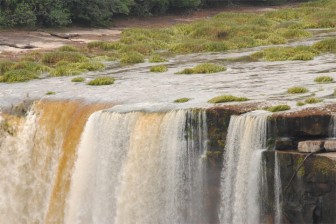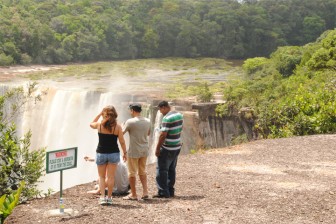Tour operators say the ambience of Guyana’s Kaieteur Falls never fails to impress intrepid travellers, nature lovers who revel in the sheer power of the mighty Kaieteur, the rawness of the environment and the absence of too many symbols of civilization.
To seek to turn Kaieteur into a conventional tourist attraction, they say, would detract from the wild and powerful beauty of what is by far the country’s most spectacular natural attraction.

There are those who think differently. They contend that there is limit to which you can validate the ruggedness of the environment. They acknowledge that, on the one hand, the sort of overcrowding and tourist infrastructure which characterizes the Niagara Falls, is probably not desirable for Kaieteur. On the other hand they contend that if the Kaieteur Falls is to be shared with the world and if, moreover, it is to become a money-earner for the tourism sector then the time is long overdue for major investment to be made in creating the requisite infrastructure.
A quiet but often intense discourse is ensuing between those who believe that, over the years, far too little has been done to attract visitors to Kaieteur and the more conservative advocates of a policy that shows off Kaieteur to the world but, first, seeks to determine the extent to which the eco-system at what is now the Kaieteur National Park is sturdy enough to handle a surfeit of visitors.
Damien Fernandes is the Commissioner of the Protected Areas Commission and a skeptic on the matter of simply kicking down the door and letting everyone in. Not that he disagrees with the idea of sprucing up the area of the Falls and rendering it more visitor-friendly. He points to the fact that the area has recently benefited from the creation of a Visitor Arrival Centre built with funds provided by the German Government. The truth is, however, that it does not provide much more than bathroom facilities.
The Guest House too is sparsely equipped to accommodate visitors. There is no cooking, no discreet bar, no craft or souvenir shop and no other form of recreation beyond seeing the falls itself.
Fernandes says that there is a management plan in place which, presumably, seeks to help Kaieteur boost its visitor numbers beyond the approximately 6,000 visitors a year though there is no plan to accede to what Stabroek Business understands has been at least two requests from local tour operators to take over the running of the entire facility

No one, it seems, questions the challenge associated with balancing the competing interests associated with the Kaieteur Falls though even the tour operators with whom this newspaper spoke believe that more official attention can be paid to the Kaieteur Park as a whole. These operators undertake several trips to the falls weekly, both by air and overland and when they do they must take with them everything that their visitors might need.
If the views expressed by Fernandes are anything to go by, however, the government appears in no mood to seriously hasten the pace of development as far as improving the facilities at Kaieteur is concerned. Here, the argument has to do with the importance of preserving the unspoilt beauty of the Kaieteur area and an apparent concern that it not become a thoroughfare to the extent that it compromises a precious protected area. The problem with that argument is that the authorities, while wanting to continue to promote the falls as the country’s key tourist destination still appear altogether unsure as to the level of visitor arrivals that would be safe to ensure the protection of the area. And while Fernandes does not come across as the run-of-the-mill state bureaucrat, he too favours a cautious approach that addresses the science of protecting the environment before decisions on upgrading the infrastructure are made.
The functionaries in both the public and private sectors are discreet in their assessments of the state of affairs at the Kaieteur Falls. After we had visited the falls on Sunday and witnessed a visitor being told that the Visitor Arrival Centre could not provide a glass of water, this newspaper spoke with someone who has had a long and intimate relationship with the falls. His assessment of conditions in the area was blunt. “It’s lacking in standards,” he says. “You couldn’t buy a bottle of water there. There is a freezer in the arrival area but there is not usually anything to drink there. The building offers a washroom with running water that comes from the creek and that’s about it.”
Our Kaieteur enthusiast gives the National Park a pretty poor rating for the management of the facility. “They are doing nothing for the place,” he says, adding that accommodation at the Visitor Arrival Centre can become more than a trifle chaotic if the falls happens to be hosting three or four tours simultaneously. “There is an area where you may get a few souvenirs to buy but it is not in a prominent area where occupants of the Visitors Arrival Centre can see it immediately,” he said.
You get the impression that most people who have anything to do with the Kaieteur Falls are not inclined to speak openly about conditions there. That may be out of concern that frankness may be frowned upon or, perhaps, what they have to say might be taken out of context and may injure the image of the country’s prized natural wonder. Beneath all that, however, one senses a lingering recognition among all those with whom this newspaper spoke that we can do better with Kaieteur.




